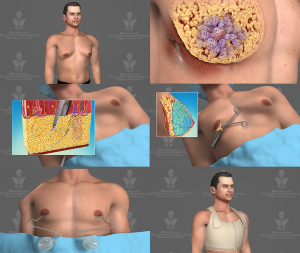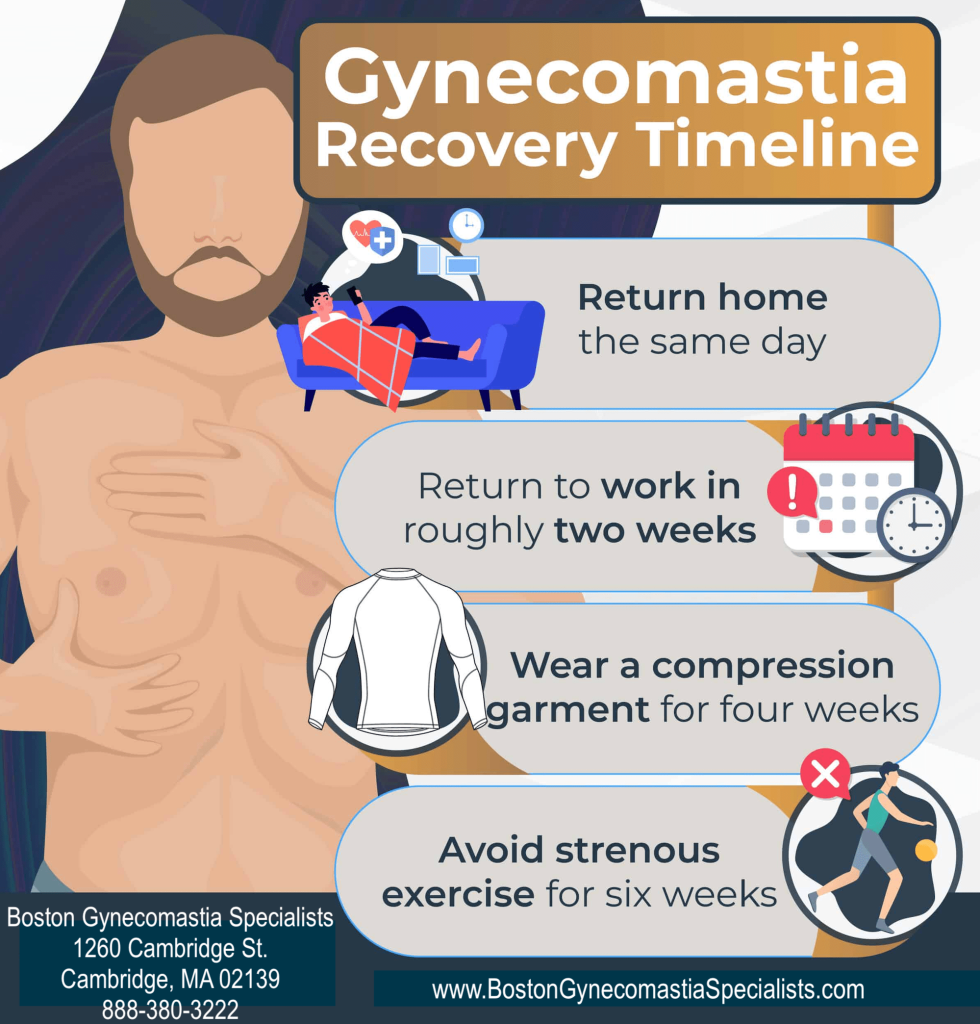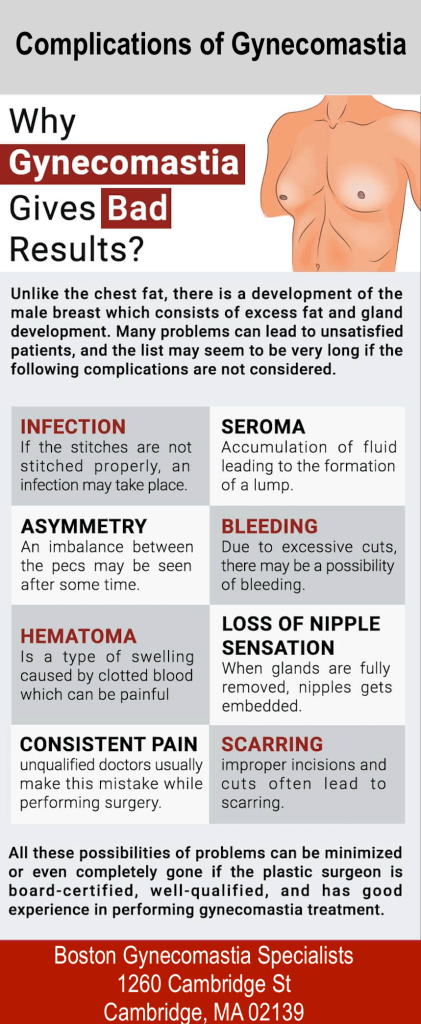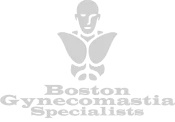
Gynecomastia Surgery Timeline
Gynecomastia surgery varies according to a number of factors – your gynecomastia grade / components and your overall health and physical condition can be two of the biggest variables in this equation, for instance. However, there is a general timeline that you can expect to arise with your male breast reduction surgery in Boston. Let’s look at the typical gynecomastia surgery timeline.
Night Before Male Breast Reduction Surgery
- Our staff will contact you a few days before your surgery to provide instructions, answer any questions you may have and to re-confirm your arrival time.
- Avoid alcohol and aspirin containing medications prior to your procedure.
- Make sure to get plenty of rest and arrange for a ride.
- Set your alarm to awaken in plenty of time to allow an on-time arrival.
- Notify Dr. Ishoo should you start to present any signs of an illness prior to or after surgery (fever, cough, flu-like symptoms)
- You can have breakfast, such as oatmeal, in the morning before coming in.
- After showering and scrubbing with hibiclense in the morning before the procedure, do not apply any cosmetics, antiperspirant, lotions, creams, or powders to your skin.
Male Breast Reduction Surgery Day
The big day has arrived, and you are feeling a mix of excitement and nervousness about your male breast reduction surgery day. Rest assured; you are in great hands! All of the details have been taken care of by Dr. Ishoo and his qualified team.
Dr. Ishoo performs many his gynecomastia procedures at his Cambridge office using local tumescent anesthesia, which is safe, comfortable and allows for rapid recovery.
- You will need to arrive at our office at the designated time given by the staff.
- Wear loose-fitting clothing with a shirt that closes in the front so that you will not have to pull it over your head.
- Bring your ID, medications, and glasses.
Keep yourself calm and relaxed and let our staff take care of you through the surgical process.
After surgery, you will be moved to a recovery room. Recovery times vary with each patient and the procedures being performed.
We will arrange for your ride back home to pick you up or an Uber to get you back to your residence. It is now time for you to rest and recover.
Don’t forget, you are one step closer to achieving your goal of having the masculine chest you have always wanted!
Schedule a Consultation
If you are considering gynecomastia surgery, fill out our online contact form or call us at (888) 380-3222. Dr. Ishoo, with over 15 years experience, is ready to assist you with your physical health needs once you schedule an in-person consultation.
After Gynecomastia Surgery Instructions
Although everyone struggling with gynecomastia surgery recovery is different, Dr. Ishoo has compiled a list of side effects and recovery care steps to help make the most of your downtime and overall results.
Below you will find a comprehensive list of important instructions and guidelines for post-operative care after gynecomastia surgery with board-certified surgeon Dr. Ishoo. One of the key factors to a successful experience after gynecomastia surgery is following the instructions and guidelines provided. Our goal is for our gynecomastia patients to have the best surgical journey possible.
If you have already had surgery with another surgeon, please use the information below as a guideline only. Each surgeon has his/her own specific post-operative instructions and healing guidelines they will want you to follow.

What to Know After Gynecomastia Surgery
Nausea
The local anesthesia for your surgery is designed to avoid or minimize nausea, however, some patients may still experience this. If nausea occurs, take the Zofran tablet immediately. Pain medications and antibiotics can often cause nausea as well. Be sure to take these medications with food. If your nausea persists, you may consider stopping the pain medication. Take Tylenol to help with pain/discomfort.
Activity
Immediately following gynecomastia surgery you will want to rest. Once you feel up to it get something light to eat and take medications as instructed. during the day and evening you will want to get up and walk around for 15 minutes every hour to promote proper blood circulation. Avoid lifting anything heavier than 5 pounds, lifting children, or having sex for 2 weeks.
Hydration
Keep Gatorade or Pedialyte available to ensure proper hydration. Make sure you drink a lot of fluids during your recovery period.
Sleep
After gynecomastia surgery, it is important to rest and sleep at a 45-degree angle on your back for at least the first 3 days. Continue to do so until you feel comfortable sleeping the way you normally do. This will vary from patient to patient. Important – soreness may make it very difficult to get to sleep the night after surgery. In order to maintain your normal sleep schedule, we recommend taking Tylenol 1 hour before you plan to sleep. This may help with the discomfort.
Garment/bandage
For the first 24 hours after gynecomastia surgery you will have bandages and a binder wrapped around your chest. Generally, you will be instructed not to undo your compression; however, you may adjust your garment/bandage as needed to obtain consistent, gentle compression. Dr. Ishoo will usually remove any drains and the bandages at your first post-operative visit. He will advise whether or not to continue using gauze or pads on the incisions.
Post-operative garment/shirt
At day 2 or 3 the incisions should no longer ooze. At this time you may switch to placing a mesh vest on first and then the ABD pads under it and then put on the compression vest for more comfort.
Shower
If possible, don’t shower for the first 24 hours following your gynecomastia surgery. Your chest will be bandaged and you don’t want to get them wet. If you must bathe, take a sponge bath and avoid getting water on the bandages. After your first visit, Dr. Ishoo will remove some of the bandages and check your chest. Once you arrive back home it is fine to shower. Be careful as it is not uncommon to be dizzy. Simply remove the garment and take a luke warm shower. Allow the water to drizzle down over your chest. It is OK for the surgical tape on the incisions to get wet. Afterwards, pat dry and put your garment/bandage back on. No baths for the first 2 weeks or as long as the incisions are still open.
Ice
You may apply ice packs or gel packs to the breast area for the first 2 days. Do not apply directly to skin. The area will be numb following gynecomastia surgery, so you may not feel the cold from the ice, which could result in frost-burning the skin.
Incision care
The sutures Dr. Ishoo uses will dissolve on their own. You will have surgical tape over the incisions to promote optimal healing. We will change the surgical tape on the incisions at about 10-14 days. When we change your tape for the first time, you will then begin doing this yourself every 5-7 days for 12 weeks.
Driving
Do not drive for the first three days, while on pain medications, or if you feel impaired in any way.
Blood thinners – Do not use aspirin-containing products for at least one week. You may take Tylenol or pain medication as prescribed.
Exercise
You can exercise areas other than your chest at two weeks following gynecomastia surgery. Begin with non-impact cardio and light weights. It’s important to progress very slowly. If you feel any discomfort in your chest, your body is telling you you’re doing too much. Swelling will delay your recovery and may cause other problems. Listen to your body. Typically, it takes eight weeks to begin working out your chest and to return to impact/cardio activities (running, etc). You should also avoid carrying a backpack or messenger bag over your shoulders for the first 2 weeks after surgery. You want to avoid tension or strain on your chest, so your incisions heal properly. Many bodybuilders are interested in the use of steroids after surgery. Consult with Dr. Ishoo prior to doing so.
Work
Typically, you can go back to sedentary jobs within 3 days following gynecomastia surgery. Physical jobs could take anywhere from 1-2 weeks. Often, patients with physical jobs will modify their job or get someone to help them the first week so they can get back to work quicker. The time you need off work will also depend on how quickly your body recovers. Everyone heals at a different rate. We can typically provide a letter stating you will need a certain amount of time off from your job. The letter will not state the procedure you had or anything other than Dr. Ishoo’s name. It won’t say anything about plastic surgery. You can also inquire about going on short-term disability through the State.
Sun exposure
Avoid direct sun exposure on the incisions for at least 6 weeks. After 6 weeks, apply sunscreen (at least SPF 15) to the incision area. If possible, it’s best to avoid the sun completely for up to 3 months.
Smoking
Do not smoke for at least 1 week after surgery. We prefer you quit permanently.
Medications
Be sure to take all medications as directed. If you develop a reaction to any of the medications, please stop taking it and call our office so we can prescribe an alternative.
Bruising
If bruising occurs, you can apply Arnica Montana cream to help them fade more quickly. Avoid applying the cream directly on the incisions. Bruising usually clears up within 2-3 weeks.

What to expect as you recover
Lack of energy
You may experience decreased energy levels for up to 8 weeks. Try to maintain a healthy diet and drink lots of water throughout the recovery process. It’s also important to get as much sleep as you can and listen to your body. It will tell you when you are doing too much too soon.
Swollen chest area
It is common for the pecs to be swollen and tender after gynecomastia surgery. Do not be concerned as this will subside with time. It’s important to know the body heals asymmetrically. One side of the chest might be more swollen than the other, but this is common, do not be concerned. If there is a strong difference in the swelling, please call our office. It takes approximately 3 months to achieve the final results.
Scarring
Incisions will eventually fade to an unnoticeable color. It may take up to a year for the incisions to fully heal. Please continue to use the surgical tape provided by our office for a period of approximately 12 weeks or until Dr. Ishoo advises otherwise. After that time, you might be advised to start using Mederma® scar gel to help improve the redness. Incisions always improve over time and require patience in doing so.
Scar tissue
After weeks or even months some patients begin to notice lumpy bumpy areas in their chest. This is scar tissue formation beneath the skin, which is a common side effect of gynecomastia which will improve over time with massaging as instructed by Dr. Ishoo.
Emotional ups and downs
It is very common to experience emotional ups and downs following surgery. This can happen immediately after or days and even weeks post-operatively. Remind yourself this is normal and will pass. Reach out to those who will listen and be supportive. Remember you are not alone. If you don’t have family or friends who you feel will help you through the emotional lows, reach out to support groups on CSF, Real Self, or Gynecomastia.org.
Itching
During the healing process, your surgical site may itch. This is normal and can be a sign of progression through your recovery. Avoid scratching or itching the area, so you don’t cause further irritation. You can use hydrocortisone cream around the area to help minimize the discomfort.
Nipple sensitivity
Your nipples may become hypersensitive or lose sensation for the first 3 months. In most cases, this will go away on its own with time. When the nerves start to heal, you may feel sudden sharp pains. This is a sign that your body is progressing through the healing process.
What to watch for and when to call us
Avoiding blood clots
It is important to walk at least a 5 minutes every hour while you’re awake for the first 3 days following surgery to prevent blood clots (do not overdo it). Pay specific attention to leg pain and swelling particularly if it occurs only on one side. If you notice persistent calf pain and/or swelling contact the office.
Constipation
Constipation is one of the biggest problems we encounter after surgery, yet, few people talk about it. If you have a history of constipation, we strongly encourage you to take Colace daily starting the day of surgery. If you have not had a bowel movement by day 2, begin drinking 1 glass of prune juice daily until it resolves. Otherwise, you may want to stop taking Vicodin or other narcotic pain medication and take a laxative (Ex-Lax or Correctol).
Continue with the Tylenol as this does not cause constipation. Make sure you are walking and drinking plenty of fluids as this stimulates the GI tract. Eating fiber-rich food can also help regulate bowel movements.
Fever prevention
Make sure to cough and take deep breaths, as a fever is usually in the lungs for the first 3 days after surgery. Expanding the lungs with deep breaths easily corrects the fever. If you have a fever over 101 degrees call us.
Infection
Infection after removing excess breast tissue is very rare but, as with any surgery, it is possible. You will be provided a prescription for antibiotics which you should start the day before surgery and continue until completed. Infection becomes noticeable usually between 10 days and 4 weeks after surgery. During this time pain and swelling are normally decreasing. If, however, pain and swelling are increasing we need to look into the cause.
Significant drainage that requires frequent gauze change needs to be evaluated as well. Call the office immediately. Keep in mind though, the number one cause of increasing pain and swelling after breast augmentation is overdoing it and not an infection.
Unexplained shortness of breath
Usually shortness of breath after male breast reduction is due to the tightness from the implant or post-surgical anxiety. If, however, it becomes significant where you can’t catch your breath it is recommended to give us a call.
Collection of fluid
If you notice a substantial difference in the swelling of one of the sides of your chest, give us a call.
If you need to contact us
Please call the office during regular business hours @ 617-714-4143, after-hours call Dr. Ishoo directly at the number provided after the procedure. If either of the previous numbers fail please call our backup line @ 888-380-3222. If you feel you have a problem do not hesitate to contact us. We are here to make sure you get the absolute best care possible.
Nutrition and Healing Aids
Nutrition
While nutrition is always important for your overall health, it’s especially important prior to and following gynecomastia surgery. Increasing your protein intake, Vitamin C and Omega 3 can provide a better environment for your body to heal. There are numerous other dietary recommendations you should consider as part of your post-operative care.
Healing aids
There are various healing aids on the market that can help decrease bruising and swelling and contribute to a quicker healing process. Some of the vitamins and supplements to know about are:
- Vitamin C
- Zinc and Vitamin A
- Bromelain
- Arnica Montana cream and pills
Healing Process
Possible Healing “Speed Bumps” / Complications Gynecomastia Surgery
This section provides detailed information about some of the issues that can arise during the gynecomastia healing process following surgery. Some patients may experience none of the items listed, while others may experience one or more.
Use this information as a helpful resource should any of these apply to you and, as always, please contact our office should you have a concern with your gynecomastia healing process.
Asymmetric healing progression
Causes: Asymmetric swelling is the most common side effect you may encounter during the gynecomastia healing process. There are several factors that can cause this. Whenever dealing with pairs of any body part, you are likely to have asymmetric swelling. This can be caused by one muscle being stronger or more tense than the other, skin elasticity, more breast tissue on one side, fluid retention from the numbing medication, etc. This is all very normal and will get better as swelling goes down.
Treatment: Compression is extremely important during the gynecomastia healing process and plays a big part in assisting the swelling and fluid to drain out as it promotes proper blood circulation, also helping to prevent blood clots from forming. Compression also ensures the skin heals nice and flat to the chest wall. We also recommend icing for the first 2 weeks following surgery.
Indentation After Surgery
Symptoms:
- Chest appears overcorrected
- Indent on one or both sides
- Chest indents when flexing muscles or elevating arms
- Chest can appear distorted
Indentation healing progression
Treatment: There is no treatment needed since this will get better with time. In most patients this can take several months to fully flatten and smooth completely out.
Inverted nipples after surgery
Symptoms:
- Nipples inverted
- Nipples unable to get hard
Causes: With almost any surgery involving incisions nerves get cut and can take several months to regain full sensation. Most patients will experience numbness during the gynecomastia healing process but may not notice other side effects depending on the area of operation.
With gynecomastia surgery, the incision is made around the areola to conceal the scar, and since nerves get cut, the patient will typically experience some degree of numbness after surgery often followed with inverted nipples due to the nerves being temporarily non-functioning. This can take weeks but more often months to fully regain sensation and the ability for the nipples to harden.
As nerves begin to re-attach you may also experience itching, burning sensations, tingling around the surgical area, or shooting pains. All of these sensations are normal in the healing process.
Treatment: Always notify Dr. Ishoo if you experience inverted nipples after surgery so we can document nerve sensation at each follow-up visit. There is no treatment since the nipples will correct on their own as the internal healing is complete.
Rash/ Itching
Symptoms:
- Small pimple like bumps (often mistaken for body acne)
- Hives
- Redness followed with itching
- Excessive itching (minor itching can be normal with wound healing)
- Redness directly around surgical tape
- Blistering on the body or around surgical tape
Causes: Many patients may develop a rash after having surgery. This typically happens in the first few weeks following their procedure. A rash can be caused by an allergic reaction to medications, adhesive surgical tape, glue, topical creams, etc.
Treatment: The first thing you will need to determine is if the rash is caused by an allergic reaction. For example, if you have redness and itching directly around your surgical tape it is most likely an allergic reaction and you will need to discontinue use.
If the rash is on a random area of the body or non-surgical site, it may be an allergy to a medication you are taking or one that you were taking. Allergic reactions often occur even after the offending agent is stopped.
The rash typically will get worse before it gets better. This is particularly concerning as people feel that it should go away immediately. The rash may persist for months and the hyper-pigmentation may last even longer. The good news is that it typically does go away completely.
All rashes should be reported to your doctor immediately. Treatment usually consists of applying a topical steroid and Benedryl.
Stitch Abscess
Symptoms:
- Red swollen bump
- Oozing or discharge from the incision
- Opening on incision
- Whitehead on incision site
- Tenderness
- Hard string poking through incision site
Causes: A stitch abscess is the body’s reaction to a foreign object. In this case, your body notices a stitch as a foreign body which can occur with both permanent and absorbable sutures. Because your body does not recognize this object it may want to get rid of it and push it towards the surface of the skin to dispose of it.
This is very common in recovery from excess breast tissue removal and does not affect your final results. Stitch abscesses can typically occur within the first 6 months after surgery.
Treatment: If the stitch abscess is not dispensing any type of discharge or oozing on your surgical tape and it appears to be dry, it is okay to continue taping over it as normal. It will most likely flake off on its own within a few weeks.
If you do notice discharge coming from the stitch abscess, continue taping the entire incision except for that isolated area. You will need to apply a thin layer of Neosporin using a q-tip twice a day and put a band-aid over it. This may take anywhere from a few days to a few weeks to fully subside.
Once there is no more drainage on the bandaid, you may begin to apply surgical tape to the entire incision as before.
Wound Breakdown
Symptoms:
- Discharge or oozing from incision
- Visible opening on incision
- Tenderness
- Discoloartion around opening
- Burning sensation to skin around the area
- Fever
Causes: A wound breakdown is an opening of the incision in an isolated area that the body is having a difficult time healing. Wound breakdowns usually occur within the first few weeks following surgery. It is important to notify your physician if you are experiencing a wound breakdown, so they can determine if the tissue looks healthy or if additional antibiotics may be needed to speed up the recovery.
Treatment: If you have a wound breakdown, you will continue taping the entire incision except for this isolated area. You will need to apply Neosporin twice daily using a q-tip and place a large band-aid over it. This may take a few weeks to heal. Once the wound closes, you may notice the pigmentation slightly darker than the rest of the incision. This is normal and will fade out in time.
Seroma
Symptoms:
- Swelling in isolated area
- Water like effect when gently tapped with fingertips
- Soft to the touch
- Tenderness
- Asymmetric swelling
Causes: During surgery, saline solution is used to irrigate the area being operated on. Your body will naturally absorb this solution within the first few weeks following surgery. Sometimes a fluid pocket will form and will not allow the body to properly absorb it. This is known as a seroma.
Seromas are usually very easy to detect. With normal swelling, it will have a spongy feel when tapped with your fingertip. With a seroma, it will have a water wave effect when tapped with your finger.
Although a seroma is not an emergency, notify your doctor’s office promptly since you will need to have your physician aspirate it within 3-5 days of noticing the fluid collection. This does not affect your final results.
Treatment: Ideally, seromas need to be aspirated by Dr. Ishoo within the first 3-5 days of noticing it. Depending on the patient, the fluid may return and may need to be drained 1-3 times before the seroma is completely healed.
Hematoma
Symptoms:
- Excessive swelling in a short period of time
- Skin will be very firm to the touch
- Pain
- Extreme amount of pressure
- Excessive bruising in a short period of time
Causes: A hematoma is a localized collection of blood outside the blood vessels. When a blood vessel is damaged, blood can leak into the surrounding tissue. This blood may coagulate or clot. If you notice any of the symptoms above please contact Dr. Ishoo promptly.
Treatment: Hematomas must be surgically removed by Dr. Ishoo. If you feel you may have a hematoma please contact our office immediately.
Constipation
Symptoms:
- Bloating
- Unable to make a bowel movement
- Abdominal discomfort
Causes: Constipation is one of the most common things patients may encounter after surgery. We usually recommend taking stool softeners to help, but sometimes patients may require further treatment.
Constipation is caused by some anesthesia in your system after surgery; however, very rare after local anesthesia. Most patients are able to have a bowel movement within the first few days after surgery. Those who are unable to make a bowel movement by day 3 should contact their physician for further treatment instructions.
Treatment: If stool softeners have not worked, the next step would be to drink a glass of prune juice daily until on a normal cycle and take an over-the-counter suppository laxative. If still unable to make a bowel movement within 24 hours repeat instructions. If you are still unable to make a bowel movement by day 5 you need to go to an urgent care.
Muscle Pain
Symptoms:
- Chest pain
- Difficulty with arm motion
Treatment: There is no treatment needed as this is a normal part of the healing process. You may take tylenol for mild discomfort. If you have moderate to severe discomfort you may take your pain medication as directed by Dr. Ishoo.
Scar Progression
Symptoms:
- N/A
Causes: With all scars, they will go through a recovery process. After the wound has closed together, the body will form scar tissue around the area which can turn the scar pink or purple in color. This phase may last a few months before starting to fade away to a skin tone.
You may also notice small bumps along the incision line after the wound closes. This is from both internal and external dissolvable sutures. These can take a few months to fully dissolve, as this happens you will notice the scar starting to flatten.
Treatment: Scar formation can take up to 1-2 years before the process is fully completed. Dr. Ishoo may recommend Mederma gel if needed.
Post-Op Visits
Gynecomastia Post-Op Visits
Gynecomastia post-op visits are a critical component of your surgical journey towards living a life free of enlarged male breasts. Continuous communication with our office and following post-operative instructions will ensure you have the best possible experience possible, and, more importantly, obtain your desired result.
The first day after your surgery, you will have your follow up appointment with Dr. Ishoo and our staff at our office. This visit will allow us to monitor how your body is immediately reacting to surgery and will allow us the opportunity to educate you about the recovery process and what to expect as you heal. During this first post-operative visit, we will give you detailed instructions on how to care for yourself after surgery and answer any questions you may have. The following steps are typically followed during this gynecomastia post-op appointment.
- Dr. Ishoo will examine the area(s) surgery was performed to ensure proper healing.
- Dr. Ishoo will change dressings covering your incisions
- We will help you fit your compression garment and instruct you on the proper amount of pressure required for optimal healing. During this time, we may also instruct you on where to purchase additional garments as needed.
- We will provide you with your post-operative surgical kit, containing supplies you may need during your recovery. We will also instruct you on how and when to use each item.
- We will answer all your questions regarding your recovery and healing during your follow up visit.
- Future post-operative visits will be arranged according to your needs and healing time.
Please keep in mind, you may call us anytime during your stay with questions or concerns. Remember, no question is too small or insignificant. We want you to feel comfortable and secure throughout your recovery experience.
_____________________________________________________________
The Boston Gynecomastia Specialists is the premier Greater Boston Gynecomastia Center of Excellence. Our primary focus is on providing outstanding care throughout every step of your journey, from the first consultation to your full recovery. We recognize and appreciate the confidence you have in us and are unwavering in our commitment to maintaining the utmost level of patient care. Led by Dr. Edwin Ishoo, a highly skilled, board-certified surgeon with expertise and over 30 years’ experience in Male Breast Reduction, our dedicated team is fully committed to ensuring the best possible surgical outcomes tailored for each individual. Recognizing that every man is unique, we personalize our approach to meet your specific condition, needs and expectations. We welcome you to take that first step to achieving the transformation you have been imagining and contact the Boston Gynecomastia Specialists, the leading Gynecomastia Center in Boston, to meet with Dr. Ishoo for your personalized, in-person consultation and have your questions answered. Let us take the gynecomastia concern off your chest in a day and off your mind forever!



